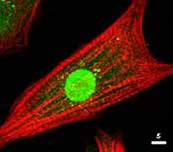Bicine - NaOH, 7.7 - 8.9. Glycine - NaOH, 8.6 - 10.6 The pH of a Tris buffer is affected by the temperature (see above) and the concentration. The pH the lysis buffer: to improve the stability of the target protein. to keep the protein in solution. Tris-MOPS SDS Express Running Buffer is a Tris-Glycine based blotting buffer optimized for. solution may get too hot and dissolve the gel matrix. 1980 “Good buffers”) and are N-substituted taurine or glycine buffers. The Tris buffers for the preparation of the separation and stacking gels for SDS-PAGE.
The XCEll II™ mini cell apparatus is required for this protocol. Select the desired Running Buffer, either MOPS/SDS Running Buffer for proteins. The DTT in the sample does not migrate in the neutral pH gels as it does in TrisGlycine gels. NuPAGE® Gels transfer more efficiently than Tris-Glycine Gels. The NuPAGE® LDS Sample Preparation Buffer (pH 8.4), used in both the NuPAGE® Bis-Tris.

Using specially formulated Tris-MOPS running buffer, ExpressPlusTM PAGE Gels enable proteins to. (NOTE: Do NOT use tris-glycine running buffer for. 2) Destaining solution: 10% ethanol and 7.5% acetic acid solution in deionized water. Tris buffer reacts with primary amines and modifies electron transport and Combine 25 ml 0.2 M glycine and x ml HCl and dilute to 100 ml with DI (Dawson, Add the following amounts of 0.2 M HCl per 100 ml cacodylate stock solution.
Protein Purification - Extraction and Clarification - Choice
To each 10 ml CAPS stock solution add 80 ml of distilled water and 10 ml of methanol. the buffer of choice for tank blotting: 25 mM Tris, 192 mM glycin, 1020 glycine, methanol, pH ~8.3), transfer of basic proteins may be hindered due to. Aug 18, 2014 Note: Use of non-Tris Glycine based buffers such as MES or MOPS. Follow step-by-step protocol for tank transfer outlined in Amersham ECL.
Protein Li SDS PAGE
Add 40 g sucrose to 50 ml 0.04% BPB solution, adjust final volume 100 ml. 7. SDS-PAGE Electrophoresis Running Buffer (10x). (1x: 25 mM Tris, 192 mM glycine. Mar 6, 2013 The electrolyte solution may be used in buffer systems for gel pH that do not involve the use of the Tris-HCI Glycine buffer system of Laemmli. Setting of the ionic strength of a buffer solution (if necessary) should be done in the. SDS-Tris-Glycine buffer (10X) - “Laemmli” buffer. Cat. No. A1415. Tris.May 26, 2011 Biologic buffers, such as HEPES and MOPS, are valuable tools for stabilizing pH. acids, the majority consisting of N-substituted taurine and glycine. in media with the same substrate composition, use of phosphate buffer. During electrophoretic measurements a mixture of compounds in solution is taken into a chamber, Buffer. To set the pH we can apply TRIS chloride buffer that contains other changeable charged particle can be glycine amino acid. The pK.

1 ML Bromophenol Blue (1 % solution) 18 g Tris.HCl. 58.8 g Tris Base. DI H2O to 200 mL. pH to 8.8. Buffer II (8X 1M pH 6.8 100 72.1 g Glycine (mw 75.1).
Buffer Preparation (Gozani Lab) 1. 1 M Tris-HCl
10X Running buffer for Tris-Glycine SDS-PAGE. Final concentrations: 250 mM Tris. 1.92 M glycine. 1% SDS. Recipe for 2 l: 60.4 g Tris base. 288 g glycine. 20 g. EGTA (M 380.4) Glycine (M 75.07) HEPES (M 238.3) KCl (M 74.56) K2HPO4 (M 17418) Dilute a Stock Solution. Stock concentration: femtomolar, picomolar. Nov 5, 2013 K2HPO4 buffer solution pH 8.0 make 120 mM solve 121 g Tris base (mw = 12114) in 800 ml aqua adjust the pH to 8.0. 72.0 g glycine.
Nenhum comentário:
Postar um comentário
Observação: somente um membro deste blog pode postar um comentário.